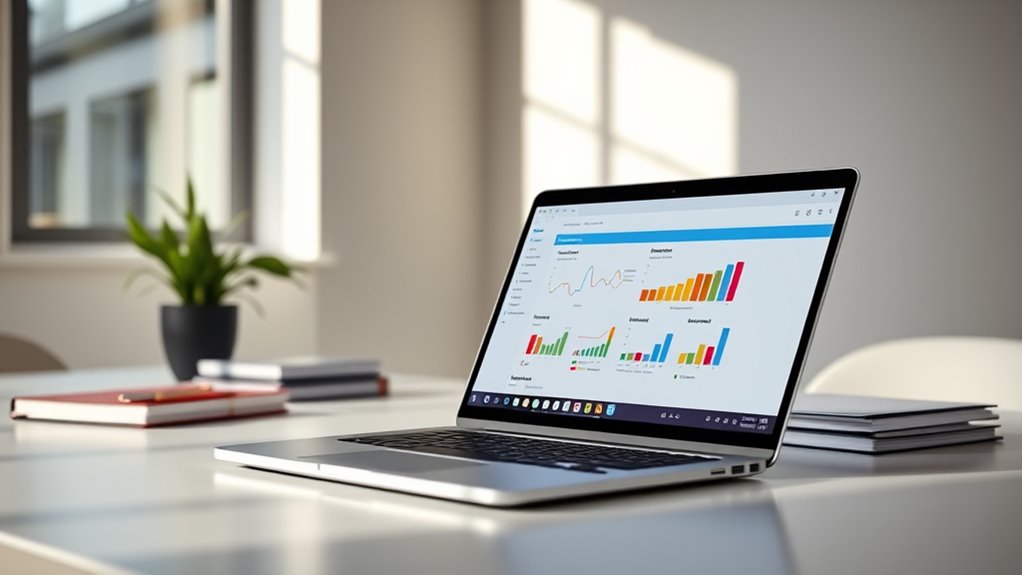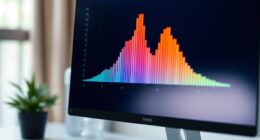Stata made simple means understanding its core features and visualization tools. While it might seem complex at first, focusing on transforming raw data into clear visuals like graphs, charts, and plots makes analysis easier. Basic commands like `graph` and `twoway` help you create customized visuals quickly. With some practice, you’ll find programming straightforward and powerful for highlighting insights. Keep going, and you’ll discover how smooth and effective data analysis in Stata can be.
Key Takeaways
- Stata simplifies complex data analysis with intuitive commands and visual tools like graphs and charts.
- Creating visuals in Stata is straightforward using commands like `graph bar` and `twoway`.
- Basic syntax and help resources make learning and customizing visualizations easy for beginners.
- Visualizations enhance data interpretation, making trends and patterns clear and compelling.
- Mastering simple commands transforms Stata into a powerful, user-friendly analysis tool.

If you’ve ever felt overwhelmed by complex data analysis tools, you’ll find that Stata is actually straightforward once you understand its core features. One of the most powerful aspects of Stata is its ability to create clear and compelling data visualizations. Instead of drowning in raw numbers, you can transform your data into meaningful graphs, charts, and plots that reveal patterns and trends at a glance. Whether you’re working with scatter plots, histograms, or line graphs, Stata’s commands are designed to be intuitive. For example, with just a few lines of code, you can generate a bar chart to compare categories or a box plot to visualize distributions. These visual tools not only help you interpret data more easily but also make your findings more presentable and impactful.
Getting started with data visualization in Stata is simple once you grasp the programming basics. You don’t need to be a coding expert; understanding the fundamental commands will empower you to customize your visuals confidently. The key is to learn how to use commands like `graph` and `twoway`, which serve as the building blocks for most visualizations. For instance, `graph bar` allows you to create bar charts with options to modify colors, labels, and axes. As you become more comfortable, you can experiment with options to refine your visuals, making sure they accurately reflect your data and clearly communicate your message.
Stata’s programming basics are designed with user-friendliness in mind. The syntax is straightforward, and many commands follow a logical structure. You start with a command like `graph`, specify what you want to visualize, and then customize it with options. This approach minimizes confusion, especially if you’re new to programming. Additionally, Stata’s help files and online resources provide step-by-step guidance, so you can quickly troubleshoot and learn new commands. As you practice, you’ll find that creating sophisticated visualizations doesn’t require complex coding—just a solid understanding of basic commands and a bit of creativity.
In essence, mastering data visualization and programming basics in Stata transforms it from an intimidating tool into a powerful ally for data analysis. With a little practice, you’ll be able to produce clear visuals that highlight key insights and make your reports stand out. You don’t have to be a programming whiz—just grasp the essentials, and you’ll unlock the full potential of what Stata has to offer.
Frequently Asked Questions
How Does Stata Compare to Other Statistical Software?
When comparing statistical software, consider how well it handles data visualization and custom scripting. Stata excels in creating clear, professional graphs and offers robust tools for custom scripting, making automation easier. You might find it more user-friendly than some alternatives, especially for social sciences. While other software may offer more advanced machine learning features, Stata’s focus on data analysis and visualization makes it a strong choice for research and policy work.
Can Stata Handle Large Datasets Efficiently?
You might wonder if Stata handles large datasets efficiently. It does, thanks to effective data compression and robust memory management features. Stata optimizes how it stores and processes data, reducing memory usage and improving speed. While very large datasets can challenge any software, Stata’s design helps you manage and analyze extensive data without significant performance issues, making it a reliable choice for handling substantial datasets.
Is Stata Suitable for Beginners With No Coding Experience?
Imagine you’re analyzing survey data with no coding experience; Stata’s user interface makes it straightforward, guiding you through commands visually. It’s suitable for beginners because of its intuitive layout and helpful prompts. While customization options are available, they’re designed to be accessible, so you won’t feel overwhelmed. With some practice, you’ll quickly become comfortable, making data analysis manageable even without prior coding knowledge.
What Are the Best Resources for Learning Advanced Stata Techniques?
If you’re looking to master advanced Stata techniques, start with online programming tutorials and data visualization resources. These resources often include step-by-step guides, example datasets, and tips for complex analyses. You can also explore specialized books or forums where users share advanced commands and code snippets. Practicing regularly and engaging with the community helps you deepen your understanding and develop your skills efficiently.
How Can I Troubleshoot Common Errors in Stata?
Imagine steering a maze of data visualization and programming interfaces—troubleshooting errors in Stata is like finding hidden clues. When you encounter errors, first read the messages carefully, then check your syntax and variable names. Use the command window for quick tests and review documentation or online forums for solutions. Break down complex code into smaller parts, and you’ll soon find your way, turning errors into stepping stones.
Conclusion
Now that you’ve glimpsed the world of Stata, you’re gently stepping into a garden of possibilities. With a little patience, the complex blooms of data analysis will open before you, revealing their vibrant secrets. Remember, every expert was once a beginner wandering through the lush landscape of learning. Keep exploring, and soon you’ll find yourself walking confidently along paths paved with insight, turning what once seemed intimidating into a journey of discovery and growth.










